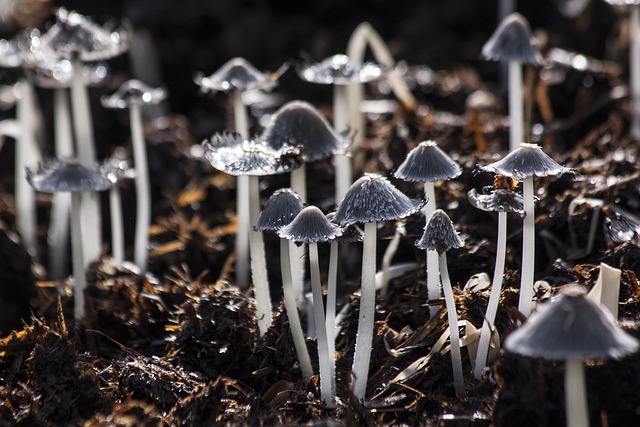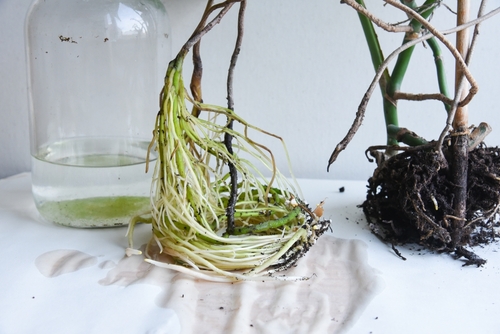Monstera root rot is definitely something to avoid. Every day you’re caring for your plants only to find them looking droopy, having leaf discoloration, or not growing at all. But, what causes Monstera root rot?
Usually, improper plant care is the one to blame for this, whether it’s in the form of overwatering, not providing adequate conditions for the plant to grow in, and more. By taking the time to understand the causes of Monstera root rot and implementing proper plant care techniques, you can ensure that your Monstera plants stay healthy, happy, and thriving for years to come. Continue reading to know all the things that lead to root rot and find out how to keep your Monstera root-rot-free!
What Causes Monstera Root Rot?

Two reasons can cause Monstera root rot: the lack of oxygen and pathogenic infection. Both things can happen because of many factors, like unsuitable environmental conditions, overwatering, or inadequate soil conditions.
While you can control some factors that cause root rot, this doesn’t mean that the plant won’t get fungal infections. However, it might reduce the chances of that happening to a great degree.
Let’s dig into the four major causes of Monstera root rot and how to prevent them:
1. Overwatering
Plants need water to flourish and survive, but too much water can have adverse effects. Overwatering your Monstera will prevent oxygen from reaching the roots, eventually suffocating your plant.
Not only does excess water suffocate the roots, but it also provides a great environment for fungi to flourish.
That said, don’t let the fear of drowning your plants cause you to underwater them. Drought can also stress your Monstera and cause the roots to die.
Here’s how to figure out when to water your Monsteras:
- Stick your fingers about an inch deep in the Monstera’s soil
- Make sure to go deeper into the soil to check the layers underneath
- If the soil feels dry and doesn’t stick to your fingers, that’s a sign your plants need watering
- You can also use a soil moisture meter for a more accurate measure
- Lastly, record the watering dates of your plant to know when to water it again
2. Poor Soil Conditions

Soil texture is vital when it comes to growing a healthy Monstera. So, if the soil doesn’t match the plant’s needs, it can also lead to root rot.
For example, sandy soil dries out fast and won’t have enough moisture for the roots. Those could cause root cell death and eventually rot.
On the other hand, dense soil takes time to drain and can become waterlogged. This can prevent oxygen from reaching the roots, risking the death of your Monstera plants.
Using too much fertilizer can also damage Monstera’s roots. Over-fertilization builds up excess salts in the soil, which absorb water. As a result, less water is available for the roots, causing them to die and rot.
Even with the proper soil mix, excess water can still get trapped at the bottom of the pot if the pot doesn’t have proper drainage.
Also, oversized pots will keep excess water than the Monstera’s roots need. The extra water displaces soil air, lowering oxygen concentration and causing root rot.
Below are some tips for planting your Monstera in proper soil conditions:
- Plant the Monstera in a high-quality potting mix that contains peat moss for good drainage
- Use pots with drainage holes and remove excess water from the pot’s saucer
- Don’t use rocks at the bottom of the pot, as they retain water and saturate the soil
- Cover the drainage holes with a coffee filter or paper towel
3. Inadequate Environmental Conditions

Environmental conditions like sunlight and temperature affect plants’ growth. Monsteras grow best in warm, humid conditions and prefer 5-8 hours of indirect sunlight.
Exposing Monsteras to temperatures below 50-55º F for a long period can lead to cold damage, making them more susceptible to pathogens.
Not only does cold weather directly weaken the Monstera, but it can also cause root rot. Lower temperatures and light intensity can retain soil moisture, increasing the chances of the disease.
Here are a few tips to help keep your Monstera healthy during winter and decrease the risks of getting root rot:
- Place your Monstera under grow light if your house doesn’t get sufficient sunlight during the winter
- Extend the period between each watering to prevent waterlogged soil
- Don’t use fertilizers (Monsteras go dormant in the winter)
- Use a humidifier to ensure the humidity doesn’t go below 60-70%
4. Pathogenic Infection

Different fungal species are the primary culprit when it comes to Monstera root rot.
Fungi are successful in causing root rot infections because they produce numerous spores that spread through water, wind, animal vectors, and even humans, causing infections to nearby plants.
Some fungal species even produce spores that can swim in water (zoospores) to reach other plant hosts.
What’s more, fungal spores are extremely resistant to heat and chemical agents. Once they find optimal conditions, the spores germinate to give mature fungi that eventually produce more spores to infect more of your precious plants.
That’s why it’s crucial to isolate infected Monstera from nearby plants to avoid spreading root rot.
After repotting, place the Monstera in a separate room with the proper growing conditions for around 40 days. Inspect them carefully before ending their isolation.
See a different post: Hoya Retusa Care
Conclusion
Several factors can cause Monstera root rot, like overwatering, improper soil texture, and fungal infections. Your Monsteras can also develop root rot due to a combination of all these factors.
So, make sure to carefully water your Monsteras and keep them in adequate soil and environmental conditions. After all, the best cure for Monstera root rot is to prevent it from happening in the first place.
Frequently Asked Questions
Can Monstera recover from root rot?
If the disease has spread entirely in the plant, the Monstera probably won’t survive.
However, if the root rot is in an early stage, you can save your Monstera plant. To do so:
– Cut away all the mushy root parts until you no longer see any dark spots inside the root.
– Transfer the Monstera into a different pot with new, well-drained soil.
– Maintain proper care and avoid overwatering the Monstera to prevent a relapse.
How do I know if my Monstera has root rot?
Usually, the leaves are the first to show signs of Monstera root rot. They’ll appear droopy with yellow or black spots (dark spots are a sign of cell death).
If you remove the Monstera from the pot and find mostly dead roots and dark, mushy stems with a foul odor, it probably won’t survive.
How do you revive Monstera roots?
To revive a neglected Monstera plant, you need to examine its roots and leaves.
If the soil appears dry, remove the Monstera plant and soak it in room temperature water for around 30 minutes. Then, let it drain excess water by placing it in a pot with holes—to prevent waterlogged soil—and maintain regular watering.
For the leaves, wipe them with water and soap to remove dust. You can also wipe the entire plant with neem oil to help fight infection.
Lastly, make sure to maintain optimal environmental conditions—partial shade, warm weather, and high humidity—to ensure proper Monstera growth.

Hey, I’m Lisa and I’ve been an avid gardener for over 30 years. I love writing, talking and living in the garden! Feel free to connect with me on my socials below

